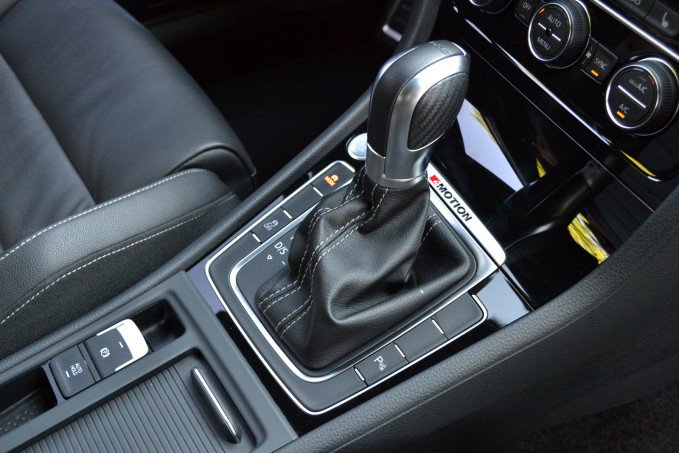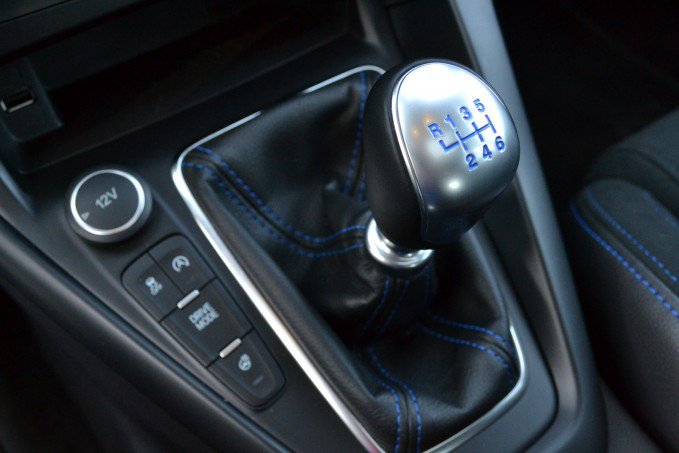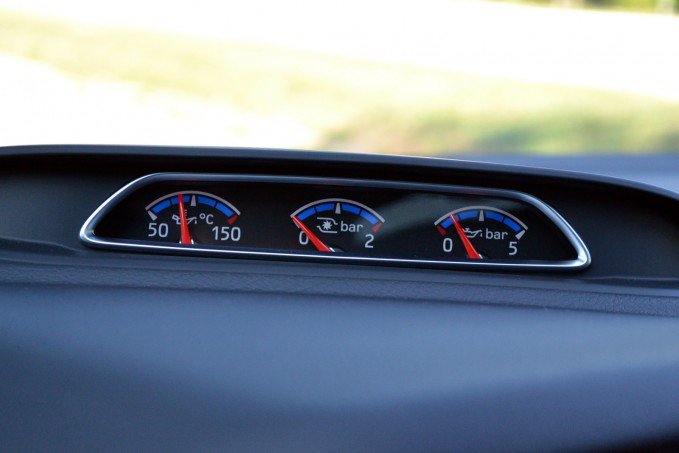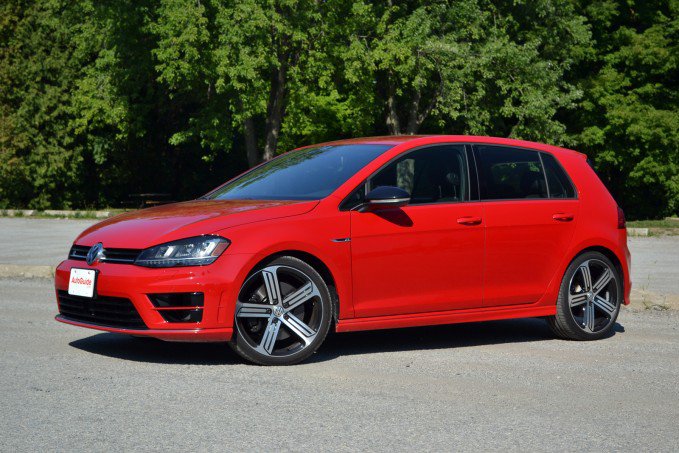It’s a good time to be a gear head.
From 700-horsepower Hellcats to supercars that are ready to blast into the stratosphere, there are plenty of high-performance players to choose from. But they aren’t exactly practical and don’t make the best commuter cars. Luckily, there are some seriously fun dual-purpose options out there for those in need. And high on that list are the Volkswagen Golf R and Ford Focus RS, the hottest of hot hatches on the market today. There haven’t been two more natural competitors since Coyote and Roadrunner. Both hatches are based on commuter cars, have powerful turbocharged engines, and all-wheel drive.
Get the Flash Player to see this player.
The Pirate’s Choice
Powered by a re-tuned version of the Golf GTI’s turbocharged 2.0-litre four-cylinder, the Golf R makes 292 horsepower and 280 pound-feet of torque, the latter of which kicks in at a low 1,900 rpm. Turbo lag is a factor, though only barely, with the all-wheel drive system helping the Golf R gallop from a rest to 60 mph in a scant 4.9 seconds (zero to 100 km/h in 5.2 seconds) with the six-speed dual-clutch automatic transmission. Capable of running through the gears faster than you can say Direkt-Schalt-Getriebe (DSG), the dual-clutch unit has the edge over the available six-speed manual, which slows the benchmarking sprint by about half a second.
The all-wheel-drive setup, Volkswagen’s 4MOTION system, can send as much as 50 per cent of the torque rearward when needed, and uses what is essentially a brake-vectoring differential to help cut understeer. Add in the adaptive damping system that can be set to comfort, normal or sport and drive mode selector, and the Golf R can be as uneventful or exciting as you want it to be.
It’s Finally Here
After collecting gallons of enthusiasts’ tears, Ford has finally unleashed the Focus RS on the North American market, and with it one of the wildest hot hatches ever built. Packing the same 2.3-liter turbocharged four-cylinder found in the Mustang EcoBoost, the Focus RS makes a ridiculous 350 hp and 350 lb-ft of torque thanks to a new twin-scroll turbocharger and larger intercooler. (That’s a jump of 40 hp and 30 lb-ft compared to the Mustang, for those of you keeping score.)
Compare Specs
All that power heads to the pavement through a torque-vectoring all-wheel-drive system that features a pair of clutch packs that can split power front to back and side to side before you even know you need it there, sending power outside, for example, to kill any semblance of understeer.
ALSO SEE: Ford Focus RS500 Could Pack 400 HP
The only gearbox available is a six-speed manual, but it is one of the finest examples on the market today, with short throws and a nicely weighted clutch that is neither too heavy or too light. Running through the gears takes no time at all, and hitting the proper shift points — which are somewhere in the 5,000 to 6,500 rpm range, depending on the mood you’re in — is rewarded with a burbling backfire that is unrivalled in the segment and beyond.
As you would expect, the RS has a drive mode selector that can be set to normal, sport or track, with all kinds of electronic trickery at play to adjust engine and steering response, suspension, all-wheel drive and traction control on the fly. Regardless of drive mode, the suspension can be adjusted independently through a button on the signal stalk, with two settings on offer: Stiff, and stiffer. Leave it in normal and you’ll feel almost every bump in the road. Put it in sport and count on a trip to the chiropractor after a long drive. Of course, none of that matters when you’re behind the wheel, with even the most mundane of drives sure to leave a smile on your face.
Inferior Interiors
One common thread tied rather unfortunately through both cars is their somewhat disappointing interiors. It’s not that there’s anything inherently wrong with either aside from the fact that there’s nothing that sets them apart from the commuter cars on which they’re based.
ALSO SEE: 2016 Ford Focus 1.0-Liter EcoBoost Review
Climb into the Golf R, and it looks and feels an awful lot like any of the more mundane Golf models out there. There’s some extra bolstering on the front seats, and the steering wheel has been swapped out for one with a flat bottom, but those are the only visual clues as to what lurks beneath the sheet metal. The same goes for the RS, with its cabin looking almost identical to just about every other new Focu
s on the road. The steering wheel, Recaro seats, and some boost and oil gauges on the dash are the only differentiators to be found. Both cars are in desperate need of something — body-colored trim pieces, carbon fiber inserts — to set them apart from their donors.
Opposite Lock
When it comes to exterior appearance, these two take very opposite approaches. Where the Golf R is understated, the Focus RS is in your face. If you’re looking for a sleeper, the Volkswagen has you covered. The tailpipes and discreet badges are about all that set it apart from the rest of the Golf lineup, which, unlike the interior, is a good thing when looking to fly under the radar.
ALSO SEE: 2016 Volkswagen Golf R Review: Quick Take
The Ford, on the other hand, is about as loud visually as it is at redline, and definitely takes a little getting used to. The gargantuan grille, massive spoiler, and rear diffuser complete with huge exhaust tips are definitely not doing anything to hide what the RS is packing under the hood. Add in the optional nitrous blue paint, and the Focus borders on aesthetically offensive, and has “cop-magnet” written all over it.
The Verdict: 2016 Ford Focus RS vs Volkswagen Golf R
So which is worthy of your hard-earned dollars? The practical buyer will likely gravitate towards the Golf R for its low-key looks, more comfortable suspension and commuter-friendly automatic. Push it hard and you can definitely feel the extra mass of the all-wheel drive system (automatic Rs tip the scales at 3,362 lb), and it doesn’t feel quite as engaging as the GTI, but the Golf R is fast and fun, and responds to throttle and steering input without a fuss. It does suffer from bouts of torque steer under hard acceleration, but tends to sort itself out with a little help from your hands, rocketing around with a cool confidence that’s hard to match. When you’re done flogging, simply put the drive selector back in normal and the Golf R transforms into a casual commuter.
But it just doesn’t have the same character or raucous exhaust note as the Focus RS. It’s not exactly livable for daily duty, with the stiff suspension and go-hard attitude enough to drive you mad on the morning commute, but it will gladly play along when pushed, nudging you further and further as the needle climbs. And just when you think the car has hit its limit — when heading into a corner a little too hot, for example — its unshakeable confidence and composure shine through, and it simply finds a way. The whole package comes together so nicely it’s scary. The car is so capable and user-friendly, I can’t decide whether that’s a good thing or a bad thing. It handles phenomenally well, laughs in the face of understeer, and puts down enough power to outrun just about any other new car this side of $50,000.












